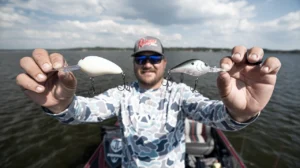FLW Tour pro Terry Bolton turns to a Zoom Super Fluke for a range of seasonal needs from the post spawn, to the fall shad bite, to any clear-water scenario when smallmouth have a good line of sight. However, the angler from Paducah, Ky. sometimes struggles with missed bites from indecisive fish that swipe at a bait without committing. But he’s found a better way to rig soft jerkbaits for bass fishing to alleviate this problem.
It can be tough to snare these fish with single J-style hooks, but Bolton modifies his presentation for greater grabbing power. Forgoing the usual extra-wide-gap hook, Bolton fits his bait with a No. 4 VMC round-bend treble.
“I like a Fluke in open-water scenarios like massive flats,” he said. “A treble hook gives you a better hook-up ratio. Because it’s exposed, all you have to do is pull and reel to set the hook.
“Sometimes, with (an EWG hook), the fish might nip at your bait, the Fluke might ball up on the hook, or something might hinder your hookset. For example, when I’m fishing fast for smallmouth and spotted bass, that bait darts and skips. But when those fish take a shot at it, that treble hook always gets them.

Rigging a Super Fluke with a treble requires a line-through connection, which Bolton creates by inserting a metal rivet sleeve into the Fluke’s nose. Because the sleeve’s diameter can make it difficult to insert without damaging the bait, Bolton uses the rivet’s center pin to plunge a starter hole. Less resistance allows the sleeve to easily slip into the bait with the flat end resting against its nose.
Bolton runs his line through this channel and out the bait’s belly. After tying on the treble, he pins one of the hook points to the bait’s belly so the other two ride roughly parallel to the bait.
Opting for Sufix Fluorocarbon, Bolton likes 12-pound line for those clear-water applications when wary fish may shy away from heavier line. Around docks or any nearby cover, he’ll push it to 14-pound fluoro, but considering also the longer casting distance of lighter line, he goes with 12-pound whenever possible.
As Bolton notes, the rivet sleeve adds weight and improves his Fluke’s casting distance. And thanks to the split ring linking line to treble, a hooked fish is less likely to come unbuttoned from this flexible rig.












